How Do You Dress a Newborn in Summer? Day, Night, and Outdoor Wear
How do you dress a newborn in summer? Parents often ask this when hot weather arrives, and for good reason. A newborn cannot control body temperature like older babies, so heat and sun can quickly cause discomfort or risk. The answer is simple: choose light, breathable fabrics, use the right layers, and protect skin from the sun.
In this guide, you will learn how to dress a newborn indoors, outdoors, and at night, with advice from pediatric experts and real parents.
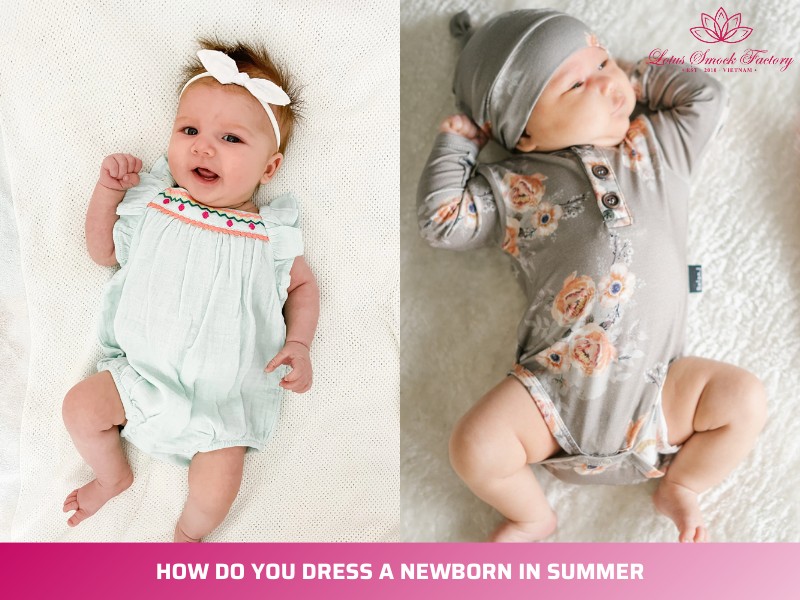
1. Why Dressing a Newborn in Summer Needs Extra Care
Dressing a newborn in summer is not the same as dressing an older baby. A newborn cannot regulate body temperature well, and overheating can happen quickly in hot weather. Light layers help, but you also need to watch for sun exposure and signs of discomfort. Below are why:
- Risks of overheating in newborns: A newborn’s body heats up faster than an adult’s. Overheating can increase the risk of dehydration, heat rash, or even sleep-related problems.
- Temperature regulation in newborns: Unlike older babies, a newborn cannot sweat effectively to cool down. Their bodies lose and gain heat more rapidly, so they need steady monitoring in warm conditions.
- Common summer discomfort signs: Look for flushed cheeks, damp hair, rapid breathing, or fussiness. These small signs show that your baby is getting too warm.
Expert Tip: As a boutique babywear supplier, we often see parents dress babies in fewer layers during summer, which is good. But many parents underestimate how quickly a newborn can get sunburnt, even while sitting in the shade. So, you should always use breathable clothing with full coverage when outdoors.
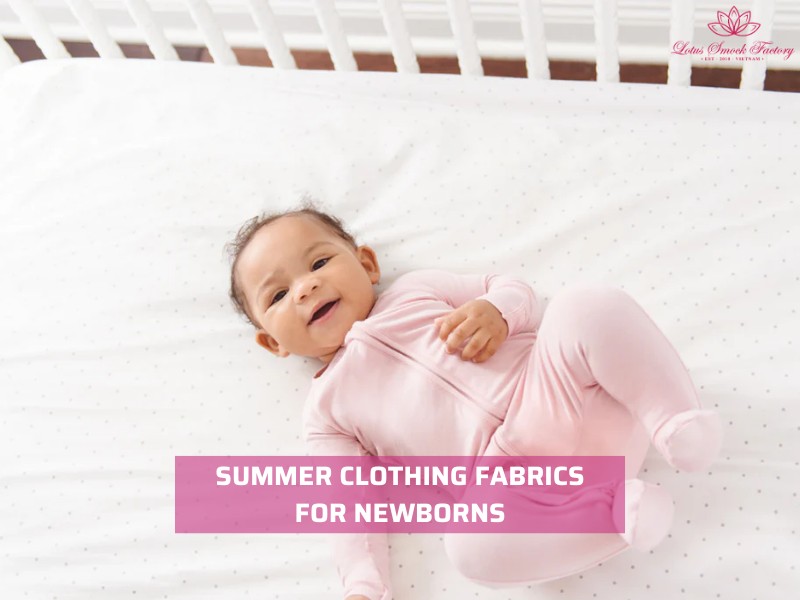
Dressing a newborn in summer needs extra care
2. Understanding Summer Clothing Fabrics for Newborns
Choosing the right fabric is one of the most effective ways to keep your newborn cool and safe in summer. Breathability, softness, and skin sensitivity all matter when you select baby clothes.
2.1. Breathable Natural Fabrics
Natural fabrics allow air to circulate and help prevent overheating. They are gentle on newborn skin and easy to wash.
- Cotton: Soft, breathable, and widely available. It absorbs sweat but can take longer to dry. Best for everyday wear indoors and outdoors.
- Muslin: A lightweight cotton weave that is extra breathable. It works well for swaddles and blankets in hot weather, but it may wrinkle quickly.
- Linen: Strong and airy. It keeps babies cool in dry heat but can feel rougher on sensitive skin. Often blended with cotton for softness.
2.2. Avoiding Synthetic Traps
Synthetic fabrics like polyester or nylon do not breathe well. They trap heat and moisture, which can lead to rashes or prickly heat.
- Polyester blends: Often used in baby clothes for durability, but they hold sweat against the skin. This makes them uncomfortable for long summer days.
- Tip for parents: If you buy a garment with polyester content, use it only in cool, air-conditioned rooms, not outdoors.
2.3. Fabric Weight & Weave
Even natural fabrics can exhibit different properties depending on their weight and weave.
- Gauze: Very light and airy. It is perfect for swaddles, blankets, or layering pieces in hot weather.
- Jersey knit: Slightly heavier but still breathable. It stretches well and is good for onesies and sleepwear.
When choosing summer outfits, always touch the fabric. If it feels heavy or makes your own skin warm, it will likely be too much for your newborn.
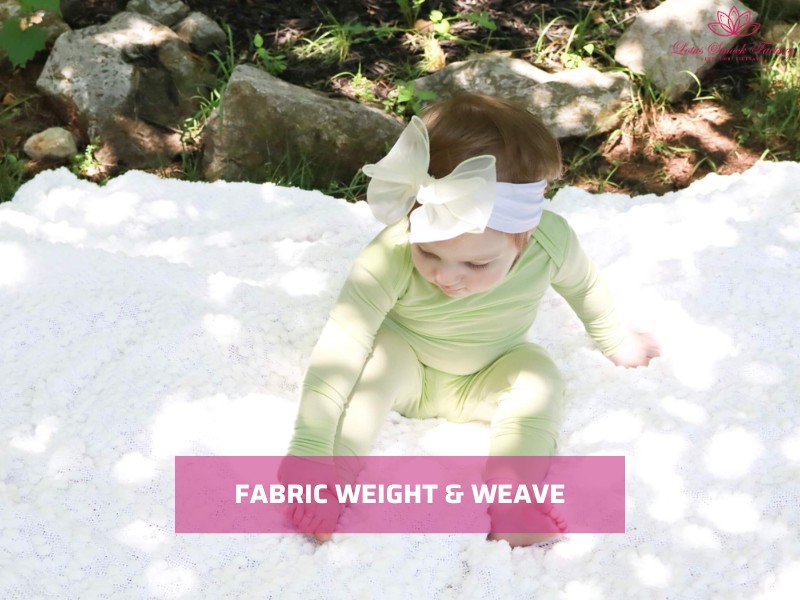
Natural fabrics can exhibit different properties
3. How to Layer a Newborn in Summer
Layering helps you balance comfort and protection for your baby in different summer settings. You don’t need many clothes, but you should choose light, breathable pieces that match the temperature.
3.1. Indoors in Air Conditioning
Babies can feel chilly in air-conditioned rooms. A simple setup usually works best:
- Lightweight cotton onesie: Soft, breathable, and keeps the body covered without adding heat.
- Thin swaddle or blanket: Use muslin or gauze for a gentle extra layer. It keeps the baby cozy without trapping too much warmth.
3.2. Outdoors in Shade
Even in the shade, summer heat can affect newborns. Protecting the skin is as important as keeping layers light.
- One breathable layer: A short-sleeve cotton bodysuit or romper keeps the baby cool.
- Sun hat: Choose one with a wide brim and preferably UPF fabric. It protects the face and neck from direct rays.
3.3. Nighttime Sleepwear in Summer
Sleepwear choices depend on room temperature, and TOG ratings make it easier to decide.
- 0.2 TOG: For rooms between 24–27°C (75–81°F). Perfect for hot nights, often just a diaper and lightweight sleep sack.
- 1.0 TOG: For 20–24°C (68–75°F). Add a short-sleeve onesie under a light sleep sack.
- 1.5 TOG: For 18–22°C (64–72°F). Works with a bodysuit or footless sleeper.
- 2.5 TOG: For 16–20°C (61–68°F). Use with a cotton sleeper underneath.
- 3.5 TOG: For rooms below 16°C (61°F). Add a long-sleeve bodysuit or footed sleeper under the sleep sack.
Note: You can also use the TOG ratings and winter temperatures to know how to dress a newborn in winter.
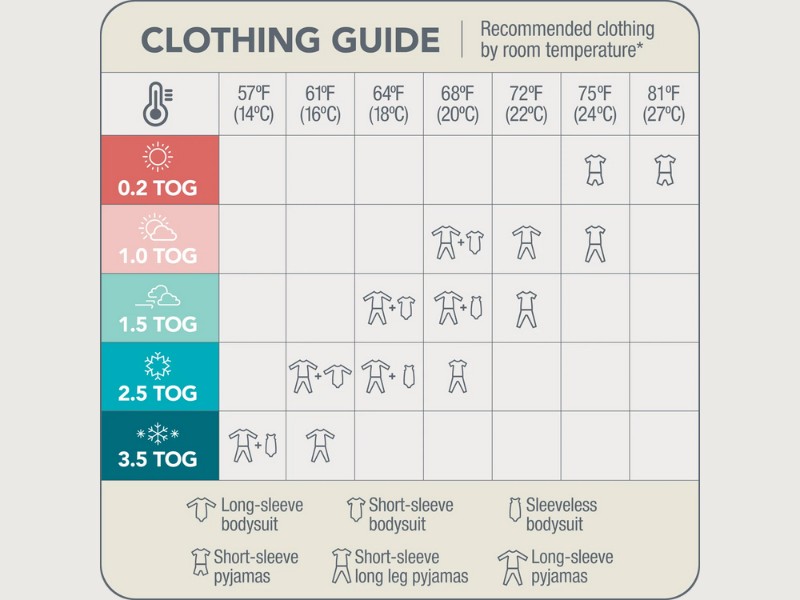
TOG ratings
Experience Insight: In the UK, many parents living in warmer flats without air conditioning prefer sleeveless bodysuits at night. In the US, where homes often use air conditioning, short-sleeve sleepers are more common.
4. Safety Guidelines from Pediatric Experts
Newborns are more sensitive to heat than older children, so following safe summer practices helps keep them comfortable and lowers risks. Pediatric experts stress three main points:
- Avoiding overheating: The baby’s room should be between 20–22°C (68–72°F), which is most suitable. In hotter climates, use a fan or air conditioning to stabilize the temperature. Place the crib away from direct sunlight and avoid overdressing.
- No loose blankets in cribs: Loose items such as blankets, pillows, or stuffed toys increase the risk of suffocation. Instead, use a lightweight sleep sack or swaddle with the right TOG rating for the room temperature.
- Watching for signs of discomfort:
- A baby who is too hot may have flushed skin, damp hair, sweating, or rapid breathing.
- A baby who is too cold may have cool hands and feet, pale skin, or appear unusually still.
- Check your baby’s chest or back to judge comfort, not just hands or feet. Adjust layers as needed.
5. Step-by-Step: How to Choose the Perfect Summer Outfit for Your Newborn
Dressing a newborn in hot weather does not need to be stressful. If you follow a few simple steps, you can keep your baby safe, cool, and comfortable all day.
5.1. Step 1: Check the day’s forecast
Look at the temperature, humidity, and UV index before leaving the house.
- High humidity makes the air feel hotter.
- A high UV index means sun protection is critical, even in the shade.
5.2. Step 2: Select a breathable base layer
Choose a light cotton or muslin onesie as the first layer.
- For very hot days, a sleeveless bodysuit works best.
- For mild warmth, short sleeves or thin rompers are fine.
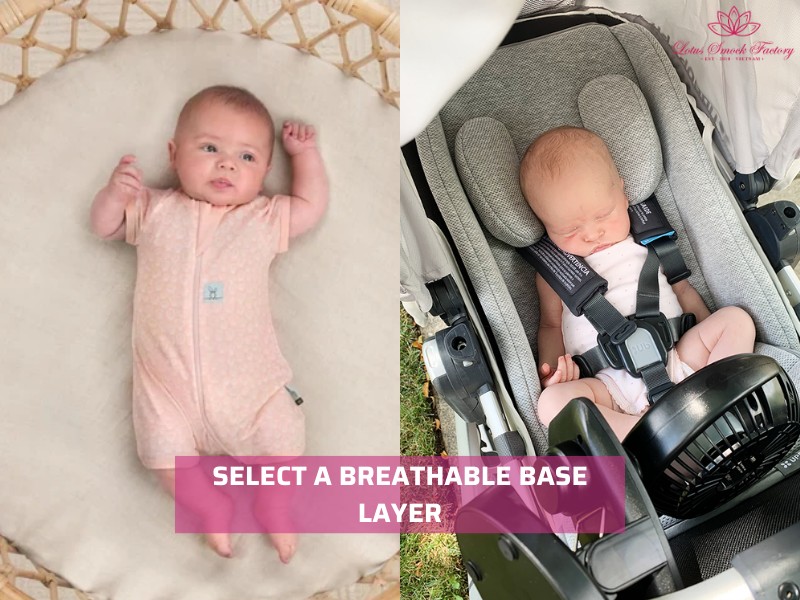
Select a breathable base layer
5.3. Step 3: Add protective accessories without overheating
Keep your newborn safe from the sun and heat while avoiding too many layers.
- Use a wide-brimmed sun hat made with breathable fabric.
- Add a thin muslin swaddle when in air-conditioned rooms.
- Skip thick socks and shoes unless the weather turns cooler.
5.4. Step 4: Monitor your baby’s skin and mood during the day
Babies cannot speak, so their body language tells you what they need.
- Signs of overheating: sweating, flushed cheeks, restlessness.
- Signs of being too cold: cool hands and feet, pale skin, fussiness.
Adjust clothing quickly if you notice these signs.
6. Regional Dressing Tips (US, UK, Australia)
Parents around the world face different summer challenges. How you dress your newborn often depends on where you live and how your home and environment handle heat.
6.1. United States
In the US, many homes and cars use air conditioning.
- Dress your baby in a lightweight cotton bodysuit indoors.
- Bring a thin muslin swaddle or blanket for cooler AC settings.
- When traveling by car, check the car seat temperature before placing your baby in it, as the fabric can get very hot in the sun.
6.2. United Kingdom
UK summers often bring heatwaves, but most homes do not have air conditioning.
- Choose the lightest layers possible, such as a sleeveless onesie or nappy with a muslin cover.
- Focus on shade when outdoors, since direct sun can heat rooms and prams quickly.
- At night, use the lowest TOG-rated sleep sack (0.2–0.5 TOG) for comfort.
6.3. Australia
Australia’s summer comes with high temperatures and a strong UV index.
- Use breathable but long-sleeved clothing to protect newborn skin.
- Pick fabrics like cotton gauze or muslin that cover without trapping heat.
- Always pair clothing with a wide-brimmed hat and stroller shade cover when outdoors.
7. Common Mistakes Parents Make in Summer Dressing
Even with the best intentions, parents often make small mistakes when dressing newborns in summer. These errors can lead to discomfort or overheating.
- Over-layering “just in case”: Many parents add an extra layer, thinking babies feel colder than adults. In reality, newborns in summer usually need one light layer only. Too many clothes trap heat and raise the risk of overheating.
- Using thick socks indoors: Babies regulate temperature through their feet and head. Thick socks in warm indoor conditions can make them sweaty and fussy. Bare feet or thin cotton socks are usually enough in summer.
- Ignoring car seat overheating risks: Car seats can trap heat quickly, especially under direct sunlight. Babies dressed warmly in a car may sweat within minutes. Always check seat temperature, dress in light layers, and use a breathable cover if needed.
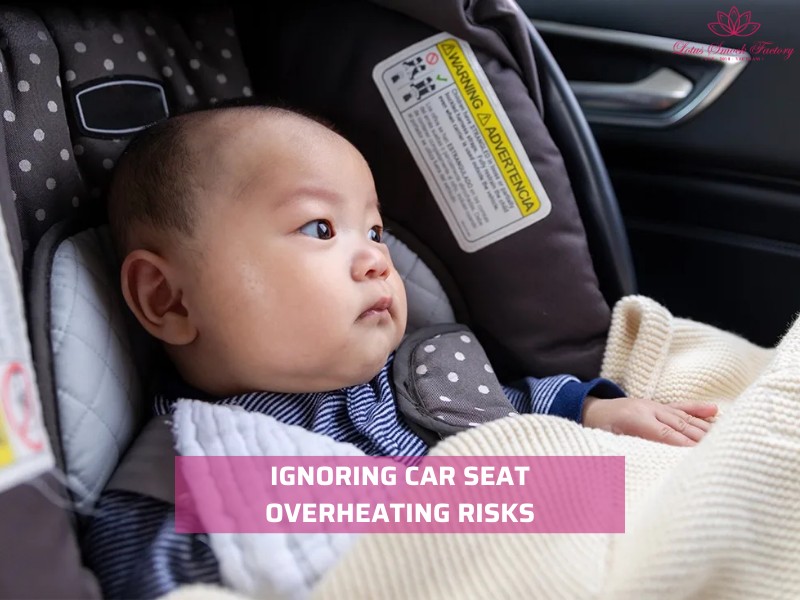
Avoid common mistakes like ignoring car seat overheating risks
8. FAQs
Q1: Can my newborn wear sleeveless clothes outside?
Yes, but only for short periods and in shaded areas. Sleeveless clothes keep your baby cool, but newborn skin is very sensitive to the sun. Add a wide-brim hat and use a light muslin cover when you’re outdoors for longer than a few minutes.
Q2: What’s the safest fabric for sensitive skin in summer?
Cotton and muslin are the safest options. Both fabrics are soft, breathable, and gentle on newborn skin. Linen is another good choice for hot days, though it can feel rougher than cotton. Avoid polyester blends, as they trap heat and may cause rashes.
Q3: How do I know if my newborn is too hot at night?
Check your baby’s neck, chest, or back. If the skin feels sweaty or hot, remove a layer. Flushed cheeks, rapid breathing, or fussiness can also signal overheating. A simple guide is to dress your newborn in one more light layer than you would wear in the same room.
Final Words
Now you know how to dress a newborn in summer without stress. Keep outfits light, protect from direct sun, and check your baby’s skin and mood often. Every newborn is different, so watch for small signs of overheating or chill.
Start with breathable fabrics, add layers only when needed, and use safe accessories. Try these tips today to keep your baby cool, safe, and comfortable all summer long.
Lotus Smock is a brand of TAQ SERVICE TRADING DEVELOPMENT JSC. In clothing business, we’ve been crafting unique pieces for the domestic market since 2010. We prioritize the quality, so we don’t accept overly big orders. We are committed to producing high-quality products at the best prices. Recently, we have started engaging in social media and marketing to reach international customers, bringing the best products from Vietnam to friends around the world.
